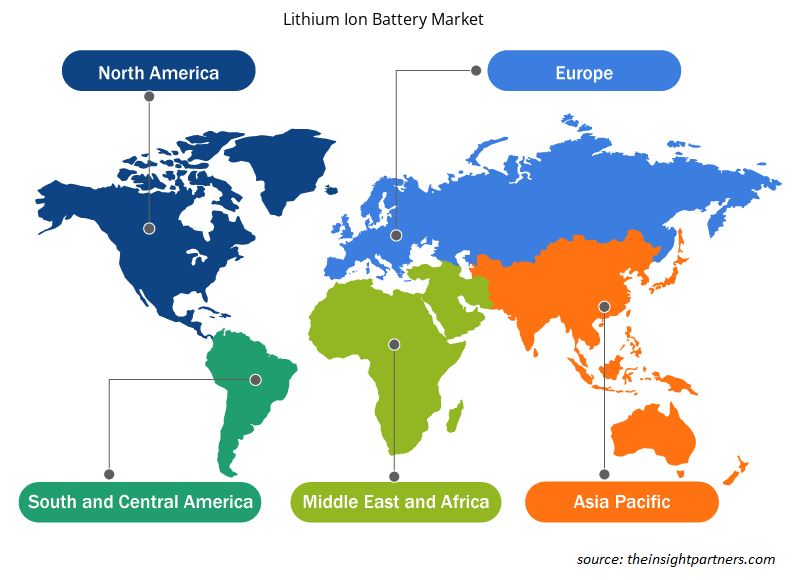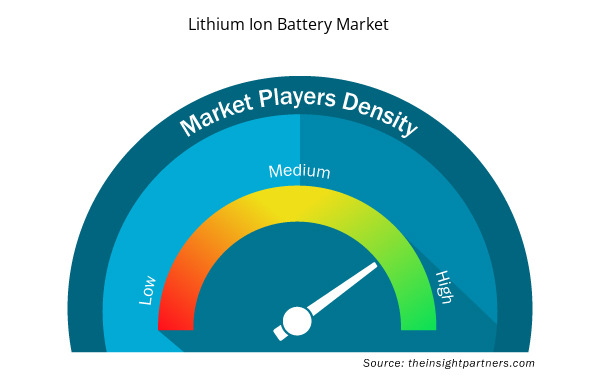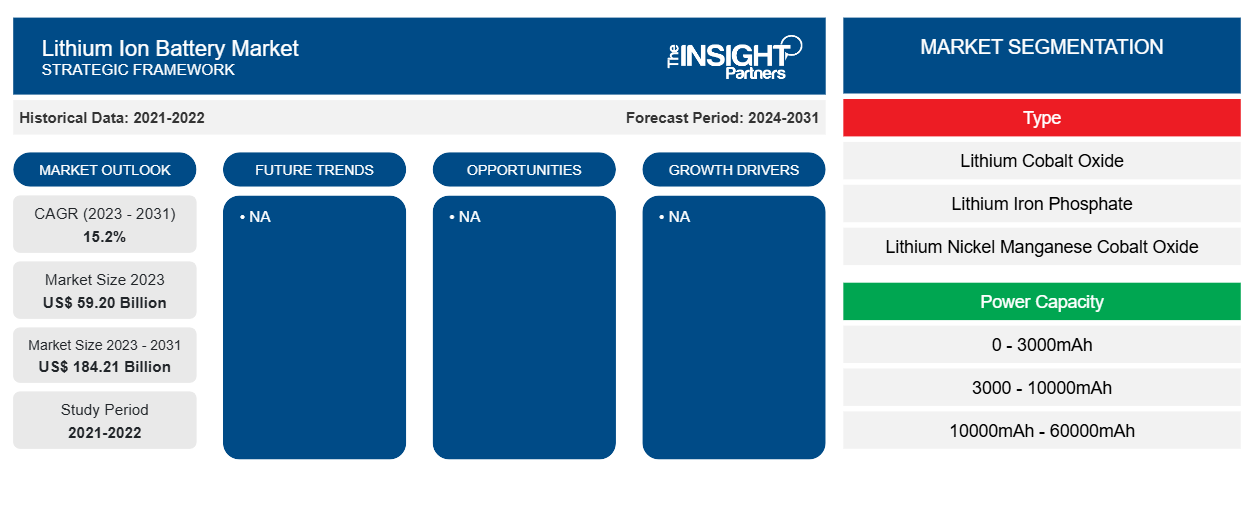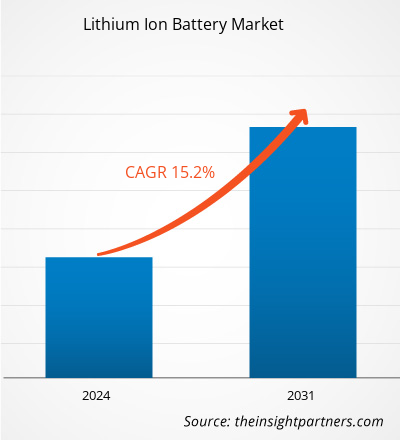Der Markt für Lithium-Ionen-Batterien soll von 59,20 Milliarden US-Dollar im Jahr 2023 auf 184,21 Milliarden US-Dollar im Jahr 2031 anwachsen. Der Markt soll zwischen 2023 und 2031 eine durchschnittliche jährliche Wachstumsrate (CAGR) von 15,2 % verzeichnen. Aufgrund der niedrigen Kosten für Lithium-Ionen-Batterien wird für den Automobilsektor ein deutliches Wachstum prognostiziert.CAGR of 15.2% in 2023–2031. The automotive sector is predicted to increase significantly because of the low cost of lithium-ion batteries.
Lithium-Ionen-Batterie-Marktanalyse
Lithium-Ionen-Batterien werden häufig als Notstromquellen für Gewerbegebäude, Rechenzentren und Organisationen verwendet. Darüber hinaus werden Lithium-Ionen-Batterien zur Energiespeicherung in privaten Photovoltaik-Systemen eingesetzt. Diese Gründe werden im Prognosezeitraum den Ausbau von Energiespeicheranwendungen vorantreiben. Lithium-Ionen-Batterien werden in einer Vielzahl von Industrieanwendungen eingesetzt, darunter Elektrowerkzeuge, Akkuwerkzeuge, maritime Ausrüstung und Maschinen, landwirtschaftliche Maschinen, industrielle Automatisierungssysteme, Luftfahrt, Militär und Verteidigung, Elektronik, zivile Infrastruktur sowie Öl und Gas.
Lithium
Marktübersicht für Ionenbatterien
Der Lithium-Ionen-Batteriemarkt bezieht sich auf die globale Industrie, die Lithium-Ionen-Batterien produziert, vertreibt und verkauft. Eine Lithium-Ionen-Batterie ist eine wiederaufladbare Batterie, in der Lithium-Ionen als primäre Ladungsträger dienen. Diese Batterien haben ein breites Anwendungsspektrum, darunter tragbare Geräte, Elektrofahrzeuge (EVs), Energiespeichersysteme und die Integration erneuerbarer Energien . Der Markt umfasst alle Aktivitäten im Zusammenhang mit der Herstellung, Forschung und Entwicklung, Rohstoffbeschaffung, Komponentenproduktion, Montage, Vertrieb und Verkauf von Lithium-Ionen-Batterien. Er besteht aus einer vielfältigen Gruppe von Interessenvertretern, darunter Batteriehersteller, Rohstoff- und Komponentenlieferanten, Batteriepack-Monteure, Anbieter von Batteriemanagementsystemen und Endverbraucher.
Passen Sie diesen Bericht Ihren Anforderungen an
Sie erhalten kostenlos individuelle Anpassungen an jedem Bericht, einschließlich Teilen dieses Berichts oder einer Analyse auf Länderebene, eines Excel-Datenpakets sowie tolle Angebote und Rabatte für Start-ups und Universitäten.
- Holen Sie sich die wichtigsten Markttrends aus diesem Bericht.Dieses KOSTENLOSE Beispiel umfasst eine Datenanalyse von Markttrends bis hin zu Schätzungen und Prognosen.
Treiber und Chancen auf dem Lithium-Ionen-Batteriemarkt
Inkl.Steigende Nachfrage nach batteriebetriebenen Materialtransportgeräten in allen Branchen begünstigt den Markt
Die Materialtransportausrüstung hat sich weiterentwickelt, um den sich ändernden Anforderungen der Industrie gerecht zu werden. Im Laufe der Zeit hat die Branche der Materialtransportausrüstung viele technologische Verbesserungen erfahren. Batteriebetriebene automatisierte Materialtransport- und Hebeausrüstung wie z. B. geführte Fahrzeuge, Hebevorrichtungen, Flurförderzeuge und Intralogistiksysteme haben sich technologisch weiterentwickelt. Lithium-Ionen-Batterien werden häufig in Materialtransportausrüstung verwendet, darunter Gabelstapler, Roboter und Bodenunterstützung.intralogistics systems, has advanced technologically. Lithium-ion batteries are widely used in material-handling equipment, including forklifts, robots, and ground support.
Richtlinien und Vorschriften der Regierung
Regierungen auf der ganzen Welt erlassen Regeln und Vorschriften, um die Nutzung von Elektrofahrzeugen, erneuerbaren Energien und Energiespeichertechnologien zu fördern. Diese Bemühungen bieten Anreize, Subventionen und Steuererleichterungen, die die Nachfrage nach Lithium-Ionen-Batterien steigern. Laufende Forschungs- und Entwicklungsbemühungen im Bereich Batterien führen zu kontinuierlichen Fortschritten bei Lithium-Ionen-Batterien. Höhere Energiedichte, längere Lebensdauer, schnelleres Laden und verbesserte Sicherheitsfunktionen sind alles Beispiele für Fortschritte. Diese Entwicklungen treiben das Marktwachstum voran, indem sie das Anwendungsspektrum für Lithium-Ionen-Batterien erweitern.
Segmentierungsanalyse des Marktberichts für Lithium-Ionen-Batterien
Wichtige Segmente, die zur Ableitung der Marktanalyse für Lithium-Ionen-Batterien beigetragen haben, sind Typ, Leistungskapazität und Anwendung.
- Nach Typ ist der Markt für Lithium-Ionen-Batterien in Lithium-Kobaltoxid, Lithium-Eisenphosphat, Lithium-Nickel-Mangan-Kobaltoxid, Lithium-Manganoxid und Lithium-Titanatoxid unterteilt. Das Segment Lithium-Kobaltoxid hatte im Jahr 2023 einen größeren Marktanteil.
- Nach Leistungskapazität ist der Markt in 0 – 3000 mAh, 3000 – 10000 mAh, 10000 mAh – 60000 mAh und >60000 mAh segmentiert. Das Segment 0 – 3000 mAh hatte im Jahr 2023 den größten Marktanteil.
- BezüglichAnwendung ist der Markt in Unterhaltungselektronik, Automobil, Industrie, Energiespeichersysteme, Luft- und Raumfahrt & Verteidigung, medizinische Geräte und andere unterteilt. Das Automobilsegment dominierte den Markt im Jahr 2023.
Marktanteilsanalyse für Lithium-Ionen-Batterien nach geografischer Lage
Der geografische Umfang des Berichts zum Markt für Lithium-Ionen-Batterien ist hauptsächlich in fünf Regionen unterteilt: Nordamerika, Asien-Pazifik, Europa, Naher Osten und Afrika sowie Südamerika/Süd- und Mittelamerika. Der asiatisch-pazifische Markt dominiert den Markt für Lithium-Ionen-Batterien. Der asiatisch-pazifische Markt ist in China, Japan, Indien, Australien, Südkorea und den Rest des asiatisch-pazifischen Raums unterteilt. Die Region ist ein führender Hersteller und Verbraucher von Lithium-Ionen-Batterien. Der asiatisch-pazifische Raum verzeichnet eine hohe Nachfrage nach Lithium-Ionen-Batterien von führenden Herstellern von Unterhaltungselektronik. Technologische Fortschritte in der Unterhaltungselektronik im asiatisch-pazifischen Raum treiben das Wachstum des Marktes für Lithium-Ionen -Batterien voran . China ist ein bedeutender Produzent von Lithium-Ionen-Batterien und macht den größten Teil des Marktes im asiatisch-pazifischen Raum aus. Die Länder im asiatisch-pazifischen Raum investieren mehr in Forschung und Entwicklung, um neue Batterietechnologien zu entwickeln, was das Wachstum des Marktes vorantreibt.
Regionale Einblicke in den Lithium-Ionen-Batteriemarkt
Die regionalen Trends und Faktoren, die den Markt für Lithium-Ionen-Batterien im Prognosezeitraum beeinflussen, wurden von den Analysten von Insight Partners ausführlich erläutert. In diesem Abschnitt werden auch die Marktsegmente und die Geografie von Lithium-Ionen-Batterien in Nordamerika, Europa, im asiatisch-pazifischen Raum, im Nahen Osten und Afrika sowie in Süd- und Mittelamerika erörtert.

- Holen Sie sich die regionalspezifischen Daten für den Lithium-Ionen-Batteriemarkt
Umfang des Marktberichts zu Lithium-Ionen-Batterien
| Berichtsattribut | Details |
|---|---|
| Marktgröße im Jahr 2023 | 59,20 Milliarden US-Dollar |
| Marktgröße bis 2031 | 184,21 Milliarden US-Dollar |
| Globale CAGR (2023 - 2031) | 15,2 % |
| Historische Daten | 2021-2022 |
| Prognosezeitraum | 2024–2031 |
| Abgedeckte Segmente | Nach Typ
|
| Abgedeckte Regionen und Länder | Nordamerika
|
| Marktführer und wichtige Unternehmensprofile |
|
Marktdichte der Lithium-Ionen-Batterien: Auswirkungen auf die Geschäftsdynamik verstehen
Der Markt für Lithium-Ionen-Batterien wächst rasant, angetrieben durch die steigende Nachfrage der Endnutzer aufgrund von Faktoren wie sich entwickelnden Verbraucherpräferenzen, technologischen Fortschritten und einem größeren Bewusstsein für die Vorteile des Produkts. Mit steigender Nachfrage erweitern Unternehmen ihr Angebot, entwickeln Innovationen, um die Bedürfnisse der Verbraucher zu erfüllen, und nutzen neue Trends, was das Marktwachstum weiter ankurbelt.
Die Marktteilnehmerdichte bezieht sich auf die Verteilung der Firmen oder Unternehmen, die in einem bestimmten Markt oder einer bestimmten Branche tätig sind. Sie gibt an, wie viele Wettbewerber (Marktteilnehmer) in einem bestimmten Marktraum im Verhältnis zu seiner Größe oder seinem gesamten Marktwert präsent sind.
Die wichtigsten auf dem Markt für Lithium-Ionen-Batterien tätigen Unternehmen sind:
- Automotive Energieversorgungsunternehmen
- Samsung SDI Co. Ltd.
- Tesla-Tochter
- Toshiba Corporation
- A123 Systems LLC
- GS Yuasa International Ltd.
Haftungsausschluss : Die oben aufgeführten Unternehmen sind nicht in einer bestimmten Reihenfolge aufgeführt.

- Überblick über die wichtigsten Akteure auf dem Lithium-Ionen-Batteriemarkt
Neuigkeiten und aktuelle Entwicklungen zum Lithium-Ionen-Batteriemarkt
Der Markt für Lithium-Ionen-Batterien wird durch die Erhebung qualitativer und quantitativer Daten nach Primär- und Sekundärforschung bewertet, die wichtige Unternehmensveröffentlichungen, Verbandsdaten und Datenbanken umfasst. Im Folgenden finden Sie eine Liste der Entwicklungen auf dem Markt:
- Im Januar 2023 erweiterte die Toshiba Corporation (TOKIO: 6502), ein Unternehmen, das sich mit seinen Technologien, Produkten und Dienstleistungen der Förderung der CO2-Neutralität verschrieben hat, heute sein SCiB-Produktangebot mit der Einführung einer innovativen wiederaufladbaren 20Ah-HP-Lithium-Ionen-Batteriezelle, die gleichzeitig viel Energie und hohe Leistung liefert.
(Quelle: Toshiba Corporation, Unternehmenswebsite, 2023)
- Im Juni 2023 erweiterte EnerSys(R) (NYSE: ENS) seine Lithium-basierten Kapazitäten mit der Eröffnung einer EnerSys Advanced Systems (EAS)-Einheit in Budapest, Ungarn, zusätzlich zu einer bestehenden EAS-Einheit in Horsham, Pennsylvania, in der Nähe von Philadelphia. Diese Erweiterungen sind eine Reaktion auf die wachsende Nachfrage nach Lithium-Ionen-Batterien. Die neue EAS-Einheit in Budapest unter der Leitung von Dr. Laszlo Nagy bietet Kunden zusätzliche Ressourcen für die Entwicklung und Montage fortschrittlicher Lithium-Ionen-Batterien. Sie beschäftigt außerdem ein Team von Ingenieuren für die Kundenbetreuung bei Lithium-basierten Anwendungen.
(Quelle: EnerSys(R), Unternehmenswebsite, 2023)
Marktbericht zu Lithium-Ionen-Batterien – Umfang und Ergebnisse
Der Bericht „Marktgröße und Prognose für Lithium-Ionen-Batterien (2021–2031)“ bietet eine detaillierte Analyse des Marktes, die die folgenden Bereiche abdeckt:
- Marktgröße und Prognose auf globaler, regionaler und Länderebene für alle wichtigen Marktsegmente, die im Rahmen des Projekts abgedeckt sind
- Marktdynamik wie Treiber, Beschränkungen und wichtige Chancen
- Wichtige Zukunftstrends
- Detaillierte PEST/Porters Five Forces- und SWOT-Analyse
- Globale und regionale Marktanalyse mit wichtigen Markttrends, wichtigen Akteuren, Vorschriften und aktuellen Marktentwicklungen
- Branchenlandschaft und Wettbewerbsanalyse, einschließlich Marktkonzentration, Heatmap-Analyse, prominenten Akteuren und aktuellen Entwicklungen
- Detaillierte Firmenprofile
- Historische Analyse (2 Jahre), Basisjahr, Prognose (7 Jahre) mit CAGR
- PEST- und SWOT-Analyse
- Marktgröße Wert/Volumen – Global, Regional, Land
- Branche und Wettbewerbsumfeld
- Excel-Datensatz


- Personality Assessment Solution Market
- Integrated Platform Management System Market
- Europe Tortilla Market
- Oxy-fuel Combustion Technology Market
- Real-Time Location Systems Market
- Ceiling Fans Market
- Lyophilization Services for Biopharmaceuticals Market
- Nuclear Decommissioning Services Market
- Saudi Arabia Drywall Panels Market
- Public Key Infrastructure Market

Report Coverage
Revenue forecast, Company Analysis, Industry landscape, Growth factors, and Trends

Segment Covered
This text is related
to segments covered.

Regional Scope
North America, Europe, Asia Pacific, Middle East & Africa, South & Central America

Country Scope
This text is related
to country scope.
Häufig gestellte Fragen
The global lithium ion battery market was estimated to be US$ 59.20 billion in 2023 and is expected to grow at a CAGR of 15.2% during the forecast period 2023 - 2031.
Increasing demand for battery-powered material handling devices across industries and technological advancement in wearable electronics are the major factors that propel the global lithium ion battery market.
Electrical vehicle boom is anticipated to play a significant role in the global lithium ion battery market in the coming years.
The key players holding majority shares in the global lithium ion battery market are Automotive Energy Supply Corporation, Samsung SDI Co. Ltd., Tesla, Inc., Toshiba Corporation, and A123 Systems LLC.
The global lithium ion battery market is expected to reach US$ 184.21 billion by 2031.
Trends and growth analysis reports related to Electronics and Semiconductor : READ MORE..
The Insight Partners performs research in 4 major stages: Data Collection & Secondary Research, Primary Research, Data Analysis and Data Triangulation & Final Review.
- Data Collection and Secondary Research:
As a market research and consulting firm operating from a decade, we have published and advised several client across the globe. First step for any study will start with an assessment of currently available data and insights from existing reports. Further, historical and current market information is collected from Investor Presentations, Annual Reports, SEC Filings, etc., and other information related to company’s performance and market positioning are gathered from Paid Databases (Factiva, Hoovers, and Reuters) and various other publications available in public domain.
Several associations trade associates, technical forums, institutes, societies and organization are accessed to gain technical as well as market related insights through their publications such as research papers, blogs and press releases related to the studies are referred to get cues about the market. Further, white papers, journals, magazines, and other news articles published in last 3 years are scrutinized and analyzed to understand the current market trends.
- Primary Research:
The primarily interview analysis comprise of data obtained from industry participants interview and answers to survey questions gathered by in-house primary team.
For primary research, interviews are conducted with industry experts/CEOs/Marketing Managers/VPs/Subject Matter Experts from both demand and supply side to get a 360-degree view of the market. The primary team conducts several interviews based on the complexity of the markets to understand the various market trends and dynamics which makes research more credible and precise.
A typical research interview fulfils the following functions:
- Provides first-hand information on the market size, market trends, growth trends, competitive landscape, and outlook
- Validates and strengthens in-house secondary research findings
- Develops the analysis team’s expertise and market understanding
Primary research involves email interactions and telephone interviews for each market, category, segment, and sub-segment across geographies. The participants who typically take part in such a process include, but are not limited to:
- Industry participants: VPs, business development managers, market intelligence managers and national sales managers
- Outside experts: Valuation experts, research analysts and key opinion leaders specializing in the electronics and semiconductor industry.
Below is the breakup of our primary respondents by company, designation, and region:

Once we receive the confirmation from primary research sources or primary respondents, we finalize the base year market estimation and forecast the data as per the macroeconomic and microeconomic factors assessed during data collection.
- Data Analysis:
Once data is validated through both secondary as well as primary respondents, we finalize the market estimations by hypothesis formulation and factor analysis at regional and country level.
- Macro-Economic Factor Analysis:
We analyse macroeconomic indicators such the gross domestic product (GDP), increase in the demand for goods and services across industries, technological advancement, regional economic growth, governmental policies, the influence of COVID-19, PEST analysis, and other aspects. This analysis aids in setting benchmarks for various nations/regions and approximating market splits. Additionally, the general trend of the aforementioned components aid in determining the market's development possibilities.
- Country Level Data:
Various factors that are especially aligned to the country are taken into account to determine the market size for a certain area and country, including the presence of vendors, such as headquarters and offices, the country's GDP, demand patterns, and industry growth. To comprehend the market dynamics for the nation, a number of growth variables, inhibitors, application areas, and current market trends are researched. The aforementioned elements aid in determining the country's overall market's growth potential.
- Company Profile:
The “Table of Contents” is formulated by listing and analyzing more than 25 - 30 companies operating in the market ecosystem across geographies. However, we profile only 10 companies as a standard practice in our syndicate reports. These 10 companies comprise leading, emerging, and regional players. Nonetheless, our analysis is not restricted to the 10 listed companies, we also analyze other companies present in the market to develop a holistic view and understand the prevailing trends. The “Company Profiles” section in the report covers key facts, business description, products & services, financial information, SWOT analysis, and key developments. The financial information presented is extracted from the annual reports and official documents of the publicly listed companies. Upon collecting the information for the sections of respective companies, we verify them via various primary sources and then compile the data in respective company profiles. The company level information helps us in deriving the base number as well as in forecasting the market size.
- Developing Base Number:
Aggregation of sales statistics (2020-2022) and macro-economic factor, and other secondary and primary research insights are utilized to arrive at base number and related market shares for 2022. The data gaps are identified in this step and relevant market data is analyzed, collected from paid primary interviews or databases. On finalizing the base year market size, forecasts are developed on the basis of macro-economic, industry and market growth factors and company level analysis.
- Data Triangulation and Final Review:
The market findings and base year market size calculations are validated from supply as well as demand side. Demand side validations are based on macro-economic factor analysis and benchmarks for respective regions and countries. In case of supply side validations, revenues of major companies are estimated (in case not available) based on industry benchmark, approximate number of employees, product portfolio, and primary interviews revenues are gathered. Further revenue from target product/service segment is assessed to avoid overshooting of market statistics. In case of heavy deviations between supply and demand side values, all thes steps are repeated to achieve synchronization.
We follow an iterative model, wherein we share our research findings with Subject Matter Experts (SME’s) and Key Opinion Leaders (KOLs) until consensus view of the market is not formulated – this model negates any drastic deviation in the opinions of experts. Only validated and universally acceptable research findings are quoted in our reports.
We have important check points that we use to validate our research findings – which we call – data triangulation, where we validate the information, we generate from secondary sources with primary interviews and then we re-validate with our internal data bases and Subject matter experts. This comprehensive model enables us to deliver high quality, reliable data in shortest possible time.


 Holen Sie sich ein kostenloses Muster für diesen Bericht
Holen Sie sich ein kostenloses Muster für diesen Bericht